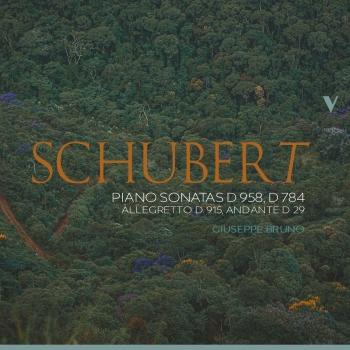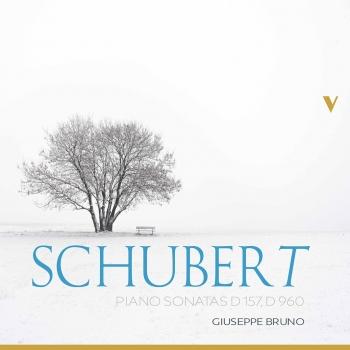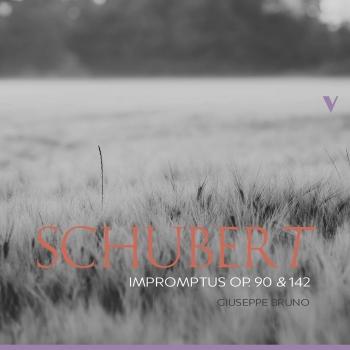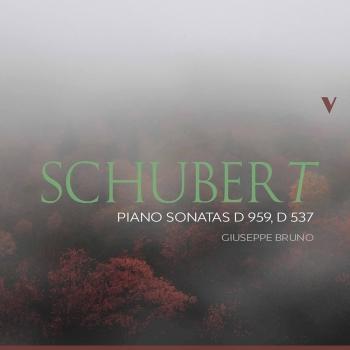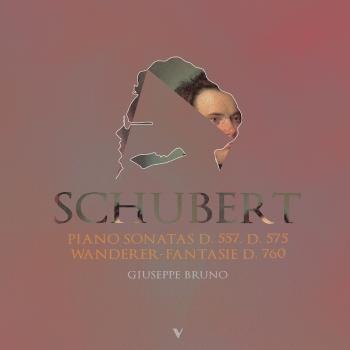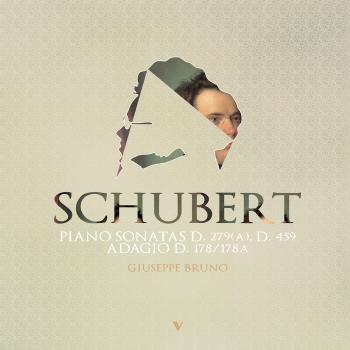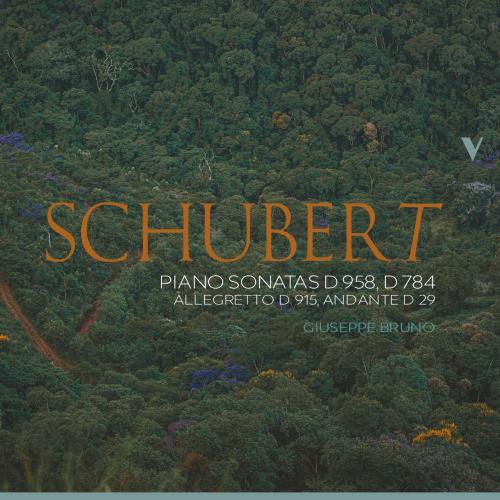
Schubert: Piano Sonatas D. 958, D. 784 & Other Works Giuseppe Bruno
Album Info
Album Veröffentlichung:
2019
HRA-Veröffentlichung:
15.11.2019
Das Album enthält Albumcover
- Franz Schubert (1797 - 1828): Piano Sonata in C Minor, D. 958:
- 1 Piano Sonata in C Minor, D. 958: I. Allegro 11:25
- 2 Piano Sonata in C Minor, D. 958: II. Adagio 08:04
- 3 Piano Sonata in C Minor, D. 958: III. Menuetto. Allegro - Trio 03:35
- 4 Piano Sonata in C Minor, D. 958: IV. Allegro 10:54
- Allegretto in C Minor, D. 915:
- 5 Allegretto in C Minor, D. 915 05:03
- Piano Sonata in A Minor, D. 784 "Grande":
- 6 Piano Sonata in A Minor, D. 784 "Grande": I. Allegro 12:43
- 7 Piano Sonata in A Minor, D. 784 "Grande": II. Andante 04:40
- 8 Piano Sonata in A Minor, D. 784 "Grande": III. Allegro vivace 05:44
- Andante in C Major, D. 29:
- 9 Andante in C Major, D. 29 04:24
Info zu Schubert: Piano Sonatas D. 958, D. 784 & Other Works
In his final year, just as in earlier attempts at composing for the piano, Schubert looked at Beethoven for inspiration. Tragic in essence, the Sonata in C Minor, D 958 presents strong evidence of this: the opening measures evoke the passacaglia-like theme that Beethoven used for his Thirty-two Variations in C Minor, WoO 80; the Adagio movement brings us back nearly three decades to the middle movement of the Pathetique Sonata; much of the material in the closing rondo seemingly derives from the last movement of Beethoven’s Sonata in E-flat Major, Op. 31, No. 3; and we might even look at the same sonata from Op. 31 to make sense of Schubert’s unusual inclusion of a Minuet, by then an obsolete dance. Pianistically, the Sonata in C Minor is a work of epic proportions. In it we may observe an attempt on Schubert’s part to make a name for himself as a composer for piano after greater recognition and financial stability characterized his final months. Published posthumously in 1839, the sonata –just like the other two sonatas written in the same year – remained out of the mainstream repertoire well into the twentieth century.
The Sonata in A Minor, D 784, completed in February 1823 and published posthumously sixteen years later, represents one of Schubert’s first mature attempts to write for the piano. The heroic albeit often tragic content of the opening movement is conveyed through writing of orchestral conception, with startling contrasts often underscored by sparse writing in opposition to expansive chords and octave passages. The brief middle movement, in F major, perhaps informed by a melodic ideas found in the Lied “An den Mond, in einer Herbstnacht” (1818), provides some relief, and features the extremely rare inscription “con sordini” (left pedal). The rondo, driven by triplets but featuring startling interruptions in full orchestral garb and a more gentle second theme, closes the sonata in an unpredictably tragic tone.
The present album includes two brief works that bookend Schubert’s brief existence – the Andante in C major, D 29, from 1812, and the Allegretto in C Minor, D 915, of 1827. One of Schubert’s earliest works, The Andante in C Major is an album leaf in A-B-A form that also survived in its version for string quartet. It already displays seminal traits I n the way Schubert develops as a composer. In contrast, the late Allegretto in C Minor was written shortly after Schubert’s first and only meeting with Beethoven, days before the latter’s death. We may be tempted to consider it a tribute to the master: echoes of the scherzo from Beethoven’s Fifth Symphony can be heard as the opening measures of the Allegretto unfold.
Giuseppe Bruno continues his exploration of Schubert’s sonatas for piano in this second album for the OnClassical label. Recorded by engineer Alessandro Simonetto at the Saletta Acustica 'Eric James', it was captured by four Brüel & Kjaer microphones.
Giuseppe Bruno, piano
Giuseppe Bruno
graduated with honors in Piano, Composition and Conductorship with Professors Specchi, Zangelmi and Taverna. Maestro Bruno specialized in piano with Paolo Bordoni and in conductorship with Leopold Hager. He has attended a seminar in composition at the IRCAM in Paris. Performing for several years as a pianist in many different chamber ensembles as well as a brilliant soloist. He has played with many important orchestras in Italy, USA, Greece, Romania and Germany in a repertory that goes from Mozart to Dallapiccola. From 1987 to 1992 he participated in the “Due Mondi” festival in Spoleto Italy and in 1988 in the Charleston festival in the USA.
In 1991 Maestro Bruno received an award at the International Piano Contest in Rome and in 1992 he received a second award in a duo with violin player Alberto Bologni at the “Viotti” in Vercelli, Italy. He recorded for Nuova Fonit Cetra, Diapason, SAM, Bongiovanni, Ars publica, Ars Musici, as well as for RAI, Swiss French and Italian radio and for WDR in Koeln. He collaborated with directors including Alkis Baltas, Spiros Argiris, Franz Lamprecht, Corneliu Dumbraveanu, violin player Sashko Gawriloff, singers Gail Gilmore and Victor von Halem, and with the Octet of Berlin Philharmonic. He is currently a member of the “Trio Petrarca”. In the past few years he has been acknowledged as a highly regarded conductor in Italy and abroad. Maestro Bruno is at present the Director of the "Giacomo Puccini" Conservatory, in La Spezia, Italy.
Dieses Album enthält kein Booklet











